Top News
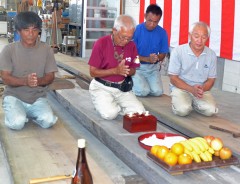
October 10, 2012 Ryukyu Shimpo
The non-profit organization called Hamasuuki, which is based in Nishizaki, Itoman, and runs the Itoman Uminchu Koubou Museum and Arts and Craft Center, was commissioned by the Ocean Expo Park to manufacture two traditional Okinawan sabani canoes. On October 4, at the Arts and Craft Center, Hamasuuki held a ceremony to pray for safety before they begin manufacturing these canoes. It has been three years since the last sabani was manufactured in Itoman. The ceremony was held around high tide. Executive Director Uehara sat on the piece of timber seven meters long and one meter wide that had been prepared for the sabani and said, “We’ll start working on it from now.” Then he and two carpenters put some sacred sake on the timber, hit it three times with a hammer and prayed for the safety of the canoes.
There are two types of sabani. One is marukinni, which is made by hollowing out a piece of timber and the other is haginni, which has two boards joined together. On this occasion, they will make the standard style honhagi and nanyohagi.
There are only two people in Okinawa who can manufacture nanyohagi. One of these carpenters, Noboru Oshiro, said, “It has been almost 20 years since last time I made a nanyohagi. Although people are interested in sabani, most people know only honhagi. I want to pass down how to make it to future generations. Kiyoshi Oshiro and his student will be in charge of making the honhagi. Oshiro said, “A sabani is a work of art, and an example of our ancestors’ wisdom. We have to really treasure this opportunity.” The two sabani will be completed by the end of this year and will be exhibited in the Ocean Expo Park’s cultural museum.
(English translation by T&CT, Megumi Chibana and Mark Ealey)
Go to Japanese
October 11, 2012 Ryukyu Shimpo
On October 10, Takeyoshi Shimoji, the deputy director general responsible for Environmental Planning in the Okinawa Prefectural Government (OPG), suggested that now that the Osprey have been deployed, the Ministry of Defense should carry out another environmental impact assessment that includes noise-related impact and possible adverse effects on plant and animal life in the Northern Training Area (NTA). The Ministry of Defense has implemented an initial assessment for relocating helipads to the NTA. Shimoji made these comments at the Special Committee on U.S. Military Base Relations in the Prefectural Assembly. The OPG will ask the Ministry of Defense to conduct another round of assessment on the NTA.
An OPG official says that its Environmental Impact Assessment Ordinance does not cover the relocation of helipads to the NTA, but both the OPG and the Ministry of Defense say that they want to avoid adverse effects on the environment due to the relocation. Shimoji said that the Ministry of Defense has not indicated its stance on the potential influence on the environment once the Osprey aircraft have begun operation.
Locals have seen the Osprey flying frequently in helicopter mode over residential areas in the vicinity of the base. They criticize the Marines for this, pointing out that the U.S. military has not observed the bilateral safety agreement set up for the aircraft. Susumu Matayoshi, the head of the Executive Office of the Governor, commented in the special committee, “I suspect that the safety measures in the agreement are not effective because the wording includes the expression ‘to the greatest extent possible.’”
With regard to the Osprey’s autorotation function that rotary-wing aircraft use when their engine stops in flight, Matayoshi commented, “While the Osprey does have an autorotation function, it is unreliable to ensure a safe landing, so it depends on other methods.” Shimoji and Matayoshi were answering questions from Masaaki Maeda, a member of the special committee who belongs to the Japanese Communist Party.
The Pentagon plans to deploy F-35 stealth fighters to Kadena Air Base. On this issue, Matayoshi said, “Whatever the type may be, the U.S. government should not deploy any aircraft to Kadena Air Base that further increase the burden on the local people.” He also added, “We have not heard that the F-35 deployment poses the sort of serious problems that the Osprey does, and we need to collect more information on this deployment.” He did not indicate a clear stance on the deployment of the F-35 fighters. Matayoshi was answering a question posed by Kiyoki Nakagawa, who belongs to the Liberal Democratic Party and is a member of the special committee.
(English translation by T&CT, Mark Ealey)
Go to Japanese
October 11, 2012 Ryukyu Shimpo
On October 10, the design committee of the Okinawa Craft Industrial Promotion Council held its second meeting at the Okinawa Prefectural Government office. In the meeting, they decided that the sanshin is appropriate to be handled under the prefectural ordinance for Okinawan traditional crafts. After the council receives the report from the committee, they will submit it to the Governor of Okinawa at the end of November, and the governor will then designate the sanshin as an Okinawan traditional craft.
It will become the 26th prefectural traditional craft designated in this manner and the first in two years, after Chibana hanaori, an Okinawan textile designated in 2010. It is expected that the designation will enable people to distinguish authentic Okinawan sanshin from those that are increasingly being manufactured overseas.
The design committee examined the requirements of the prefectural ordinance for Okinawan traditional crafts and judged that the sanshin meets the following criteria. That the craft item is used in daily life, that the essential parts used in the manufacturing process are made by hand, that the manufacturing technique has over 80 years of tradition behind it and that the craft item is made from materials that have been used since olden days. Sanshin craftsmen practice their craft in several areas.
Yoshinori Arakaki, the head of the design committee, said, “This development will enhance the status of craftsmen, promote the passing on of techniques, strengthen brand power and help to boost the local economy.”
Shinya Matayoshi, the executive head of the Okinawa Sanshin Production Cooperative lobbied for sanshin to be registered as Okinawa traditional craft. He said, “The prefectural designation will lead to promote the status of Okinawan sanshin being distinguished from the foreign products. I hope that craftsmen create high-quality sanshin and take even greater pride in their work.”
(English translation by T&CT, Lima Tokumori and Mark Ealey)
Go to Japanese
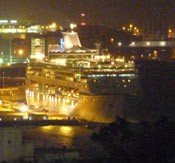
October 12, 2012 Ryukyu Shimpo
The ongoing territorial dispute over the Senkaku Islands or Diaoyutais, has caused an increase in cancellations of Chinese visitors to Japan. On October 10, the Legend of the Seas, a cruise ship from Shanghai, docked at Naha Port before departing for Amoy later the same day.
However, according to the Naha Port Authority, there were 1042 passengers on board which was not that different from the 1197 people who participated in the same cruise last year. A staff member of the port authority said that it seems as though the territory dispute has not affected this cruise. In reaction to Japan’s nationalization of the Senkaku Islands, direct flights from China to Okinawa have been suspended, new flights have been postponed, and many Chinese tourists have canceled trips to Okinawa. Private sector research had suggested that this cruise ship might not visit Okinawa and that about 2000 people would cancel, but in the end the cruise went ahead as scheduled.
(English translation by T&CT, Lima Tokumori and Mark Ealey)
Go to Japanese
October 17, 2012 Ryukyu Shimpo
In the morning of October 17, Okinawa Governor Hirokazu Nakaima met with Defense Minister Satoshi Morimoto to strongly protest about the case in which two U.S. sailors have been charged with rape. The governor asked the minister to make the U.S. military prevent the recurrence of such crimes and incidents and cooperate with the Japanese police now investigating this case. Nakaima stated in a strong tone, “A U.S. soldier assaulted a woman in August, and now the same type of crime has occurred two months later. This is just insane. We need not only to have the law enforced, but also we need to revise the Status of Forces Agreement. If we do not do this, the same type of incidents will continue to occur again and again.”
Morimoto said, “The government takes this case seriously. I think that there is something wrong with the guidance given in the U.S. military. I will press them to implement stricter and more specific measures.” He signaled his intention to convene a Joint Committee meeting in which he will raise questions to the United States about the enforcement of the law and measures to prevent recurrence of such crimes.
(English translation by T&CT, Mark Ealey)
Go to Japanese
October 17, 2012 Ryukyu Shimpo
On October 16, the Okinawa prefectural police arrested two U.S. Navy sailors who belong to Naval Air Station Fort Worth in Texas, on suspicion of a sexual assault on and injury to a woman. The police say that one of the sailors has admitted the acts of violence, stating that they committed the crime, but the other sailor has denied the charges, saying that that is not how it was. In the context of strong protests against the deployment of the MV-22 Osprey vertical take-off and landing transport aircraft, this violent incident is likely to trigger fierce opposition to the U.S. military bases among the Okinawan people.
According to the Okinawa prefectural police, the two sailors were arrested for allegedly having beaten and raped a woman in the central region of the main island. The woman had scratches inflicted on her neck when she was attacked on her way home. She was not acquainted with either of the suspects. Before the incident, the two suspects were drinking a location near the scene of the crime. Police received a report from an acquaintance of the woman, arresting one of the suspects at a lodging facility, and later apprehending the other sailor alleged to be involved in the incident.
According to the U.S. Navy in Japan, the two sailors had been working at Kadena Air Base from October 14 on support service related duty, and were scheduled to move to Guam on October 16.
The Foreign Ministry expressed its “strong regret” to U.S. Ambassador to Japan John V. Roos and requested that discipline be strengthened in order to prevent the recurrence of crimes and incidents by U.S. military personnel.
In an interview with the Ryukyu Shimpo, a spokesperson for the U.S. Navy stated that they will cooperate and support the Okinawan police in conducting their investigation, and that the U.S. Navy takes this case involving alleged misconduct by its personnel seriously. The Pentagon’s spokesperson said the same thing. Police will push ahead with the investigation of the two suspects, including carrying out a DNA test.
Because the woman’s bag was lost at the scene, the police are also looking into the possibility of the crime involving theft and robbery.
(English translation by T&CT, Mark Ealey)
Go to Japanese
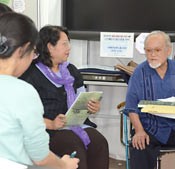
October 5, 2012, Ryukyu Shimpo
On September 20, at the exhibition at the Okinawa City Gallery Postwar Culture and History called “Histreet,” the Okinawa Municipal Historiographic Office held its regular monthly meeting of the Society for Postwar History. Meijo Nakachi, the editor in chief of the 30th anniversary issue of the magazine published by the Okinawa City Federation of Landowners Association of Land used for Military Purposes related stories about the military land in Okinawa and landowners after the war.
Nakachi is from Awase in Okinawa City. Awase was occupied by the U.S. military from April 1945. The occupation forces seized land and in August 1945 constructed an air-base to be used for attacking the main islands of Japan. Nakachi explained the crisis that the landowners faced at the time: “We had survived the war, and the U.S. military was distributing food to us. We were grateful to them until they started to occupy the land and stopped paying for the lease.”
Nakachi said that he studied the clauses of the Hague Convention with the late activist Zenko Yamashiro, who was a member of the Legislature of the Government of the Ryukyu Islands, and the late Choko Kuwae, who was Okinawa City mayor and the president of the Okinawa Prefectural Federation of Landowners Association of Land used for Military Purposes. They understood the legal basis under the Hague Convention for landowners to claim compensation for the lease of the land because the convention covers the treatment of prisoners of war and the handling of occupied land.
Looking back on those days he said, “While there were fierce struggles such as that at Isabama, we launched a silent struggle. The proposed lump-sum payment that the U.S. military implemented triggered strong opposition among the Okinawan people, because they feared that Okinawa would then belong to the United States. This led to a struggle that became known as the shimagurumi-toso (all-island struggle) and as a result, the lease contract currently used was established.
(English translation by T&CT, Kyoko Tadaoka and Mark Ealey)
Go to Japanese
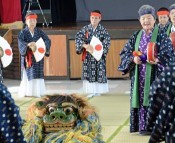
October 4, 2012 Ryukyu Shimpo
On September 30, which is August 15 in the lunar calendar, the dedicatory dance usudeku, which was first performed more than three centuries years ago, was performed in Chibana, Okinawa City. With a shishi (effigy of a lion-dog), which had been stored in a sanctuary near the community center out in front of them, 22 women paraded around the community. The women prayed to drive out evil spirits and to achieve a good harvest as they hit usudeku and walked around. Then, in a circle, they performed a solemn usudeku dance at the community center as local residents watched.
The usudeku was performed by women wearing Chibana hanaori, which is the traditional kimono of the Chibana district. This July Chibana hanaori was designated as a traditional craft by the Ministry of Trade, Economy, and Industry (METI). Members of the Chibana Usudeku Preservation Group were very pleased with the splendid occasion.
President of the group 82 year-old Yoshiko Ogimi recited a poem that she had written: “Listen young people of Chibana, METI designated Chibana hanaori, cannot be found in other communities, what a great achievement, to the world, Chibana hanaori.”
Ogimi, who has performed usudeku for about 40 years, led the parade with her sister-in-law Fumi Shimabukuro, who is vice-chairwoman.
Meanwhile, the eldest performer, 88 year-old Hideko Shimabukuro, who has also performed usudeku for four decades, said, “I have watched usudeku ever since I was a child. The elderly lady in front of me danced very well, so I would also like to keep going for a while yet.”
Director of the Chibana Hanaori Business Cooperative Naomi Kamida said, “I watched them practicing hard for today’s performance. Seeing how hard they work makes me want to do my very best weaving. As a weaver, I want to work hard to match the passionate approach of the dancers.”
Yukiko Kinjo, who at 64 year-old is the youngest dancer and the president of the Women’s Club, said, “We want to continue this traditional ceremony and help to invigorate the community.”
(English translation by T&CT, Megumi Chibana and Mark Ealey)
Go to Japanese
October 12, 2012 Ryukyu Shimpo
Stating that the idea is “unrealistic,” Defense Minister Satoshi Morimoto is reported to have rejected the Okinawa Prefectural government’s request for the deployment of the Osprey aircraft to bases throughout the nation. At his press conference on October 12, Okinawa Governor Hirokazu Nakaima voiced his strong discontent with Morimoto’s remark. Nakaima commented, “What sort of response is that? If the Osprey is supposed to be so safe, I want to suggest that all the regions of Japan should bear their fair share in the country’s defense needs. Spreading these aircraft to bases across the nation is a reasonable approach to achieve this.”
When a reporter asked the governor if the commitment is long-term would he accept the suggestion by the government that it moves the Osprey training to the main islands, Nakaima replied, “It depends on the nature of the training.” He added, “There are many things that the U.S. Marine Corps does for training. To the greatest extent possible, I want the government to transfer the training to other areas of the country, and not to allow the U.S. Marines to concentrate their training on Okinawa.” The governor also pointed out that, “If the government conducts a full review of the deployment, including the training options, they will come to the conclusion that they do not need to base the Osprey in Okinawa.
On October 24, the governor will visit Washington DC to ask the U.S. government to resolve the issue of military bases in Okinawa, including the matter of Osprey deployment. The governor said, “We have to confirm who will be the appropriate U.S. government officials to approach on the base issue. We imagine that the U.S. government will reshuffle its high ranking officials after the presidential election.”
(English translation by T&CT, Mark Ealey)
Go to Japanese
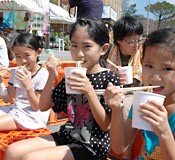
October 9, 2012 Ryukyu Shimpo
On October 6, the Motobu Commerce and Industry Association (MCIA) held a Soba Fair at Motobu, which since 2010 has been promoting itself as the home of Okinawa soba. In the fair, they provided 1000 free servings of Okinawa soba made using ingredients from Motobu. Many locals and visitors enjoyed the soba.
The ingredients included the likes of goat meat and bonito stock, fish cakes and kaori-negi, a local variety of green onions that the Motobu Farmers Association promotes. Food manufacturer Imoto prepared 1200 kilograms of local noodles that they have been selling from this year.
Yasuaki Matsuda, the head of the MCIA, said, “Welcome to Soba Town. We have a total of 67 soba restaurants and hope that many people will enjoy themselves here.”
People lined up in front of a tent in the MCIA parking lot to receive the Okinawa soba. Issei Nagayama, a fifth year pupil of Motobu Elementary School who had seven servings said, “It’s delicious,” and Umi Henzan, a fourth year pupil of the same school, ate with her friends, saying, “I just love soba.”
(English translation by T&CT, Lima Tokumori and Mark Ealey)
Go to Japanese
October 5, 2012 Ryukyu Shimpo
From November 17, Asiana Airlines, which already operates a Naha-Seoul route, will start regular flights between Naha and Busan. They plan to have two shuttle flights a week operating by March 30, 2013. Given that demand for flights to Okinawa goes up in winter, the airline will increase the number of round-trip flights between Naha and Seoul from seven to nine each week.
There have been charter flights operating on the Naha-Busan route in January and February in the past, with 12 round-trips in 2011 and 16 in 2012. Steady demand is expected on this route, so they have decided to introduce regular scheduled flights.
A staff member of the Okinawa branch of Asiana Airlines said, “Busan is the southern gateway to Korea. These regular flights will help to boost Okinawa’s profile.” As demand increases they will increase the number of flights on the Naha-Busan route to three times a week.
(English translation by T&CT, Lima Tokumori and Mark Ealey)
Go to Japanese





 Webcam(Kokusai Street)
Webcam(Kokusai Street)


